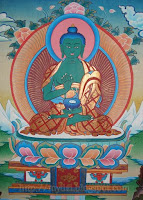The Five Dhyani Buddhas are Vairochana (White, center), Akshobhya (Blue), Ratnasambhava (Yellow), Amitabha (Red) and Amoghasiddhi (Green)
Tibetan Buddhists believe that the Adi-Buddha, the primordial and highest being, created the Dhyani Buddhas by his meditative powers. There are five Dhyani Buddha (Buddhas in Meditation). The Five Dhyani Buddhas are Vairochana (White), Akshobhya (Blue), Ratnasambhava (Yellow), Amitabha (Red) and Amoghasiddhi (Green), see thanka above .
 Dhyani Buddhas are celestial Buddhas visualized during meditation. The word Dhyani is derived from the Sanskrit words dhyana, meaning "meditation." They are also called Jinas ("Victors" or "Conquerors") and are considered to be great healers of the mind and soul. Dhyani Buddhas are not historical figures, like Gautama Buddha, but transcendent beings who symbolize universal divine principles or forces. They represent various aspects of the enlightened consciousness and are guides to spiritual transformation. They are not separate Buddha, they are just abstract aspects of Buddhahood.
Dhyani Buddhas are celestial Buddhas visualized during meditation. The word Dhyani is derived from the Sanskrit words dhyana, meaning "meditation." They are also called Jinas ("Victors" or "Conquerors") and are considered to be great healers of the mind and soul. Dhyani Buddhas are not historical figures, like Gautama Buddha, but transcendent beings who symbolize universal divine principles or forces. They represent various aspects of the enlightened consciousness and are guides to spiritual transformation. They are not separate Buddha, they are just abstract aspects of Buddhahood.
 Dhyani Buddha are so popular in Nepal and Tibet, that they are found in every stupa, thousands of chaityas, in courtyards, and found painted in the main entrance of the Buddhist house. Of the five Dhyani Buddha the senior is Vairochana (Left Image) who occupies center of the Mandala.
Dhyani Buddha are so popular in Nepal and Tibet, that they are found in every stupa, thousands of chaityas, in courtyards, and found painted in the main entrance of the Buddhist house. Of the five Dhyani Buddha the senior is Vairochana (Left Image) who occupies center of the Mandala.Each Dhyani Buddha are associated with certain attributes and symbols. Each one embodies one of the five wisdom, which antidote the five deadly poisons that are of ultimate danger to man's spiritual progress and keep him tied to worldly existence.
 Buddhists teach that the Dhyani Buddhas are able transmute the five poisons into their transcendent wisdom. The Tibetan Book of the Dead recommends that the devote meditate on the Dhyani Buddhas so that their wisdom will replace the negative forces he has allowed to take hold within.
Buddhists teach that the Dhyani Buddhas are able transmute the five poisons into their transcendent wisdom. The Tibetan Book of the Dead recommends that the devote meditate on the Dhyani Buddhas so that their wisdom will replace the negative forces he has allowed to take hold within. Each Buddha rules over one of the directions of space one of the cosmic realms of ether or space, water, earth, fire and air. The Dhyani Buddhas also personify the five skandhas, components that make up cosmic existence as well as human personality. These components are consciousness, form, feeling, perception and volition.
Each Buddha rules over one of the directions of space one of the cosmic realms of ether or space, water, earth, fire and air. The Dhyani Buddhas also personify the five skandhas, components that make up cosmic existence as well as human personality. These components are consciousness, form, feeling, perception and volition.In addition, each Dhyani Buddha is associated with a specific color, mudra (hand gesture), symbolic animal that support his throne, sacred symbol and bija (seed syllable). The bija represents the essence of the Dhyani Buddha. It can be used along with the sacred syllable Om and the Buddha's name to create mantra, a series of mystic syllables that have an esoteric meaning. In Hinduism and Buddhism, disciples recite mantras to evoke the power and presence of a divine being. In some traditions, devotees use mantras in meditation to help them be one with the deity they are invoking.




"By repeating the mantra and assuming the mudra of any Buddha," writes Buddhist monk and teacher Sangharakshita, "one can not only place oneself in correspondence or alignment with the particular order of reality which he personifies but also be infused with its transcendental power." Bhikshu Sangharakshita, A Survey of Buddhism, (Boulder, Cole.: Shambhala with London: Windhorse, 1980)


1 comments:
Some gems of knowledge once again for me! I don't have to go back 'empty handed' from your blog any time I visit!
Thank you. I will be reading your blog to know our culture.
Post a Comment